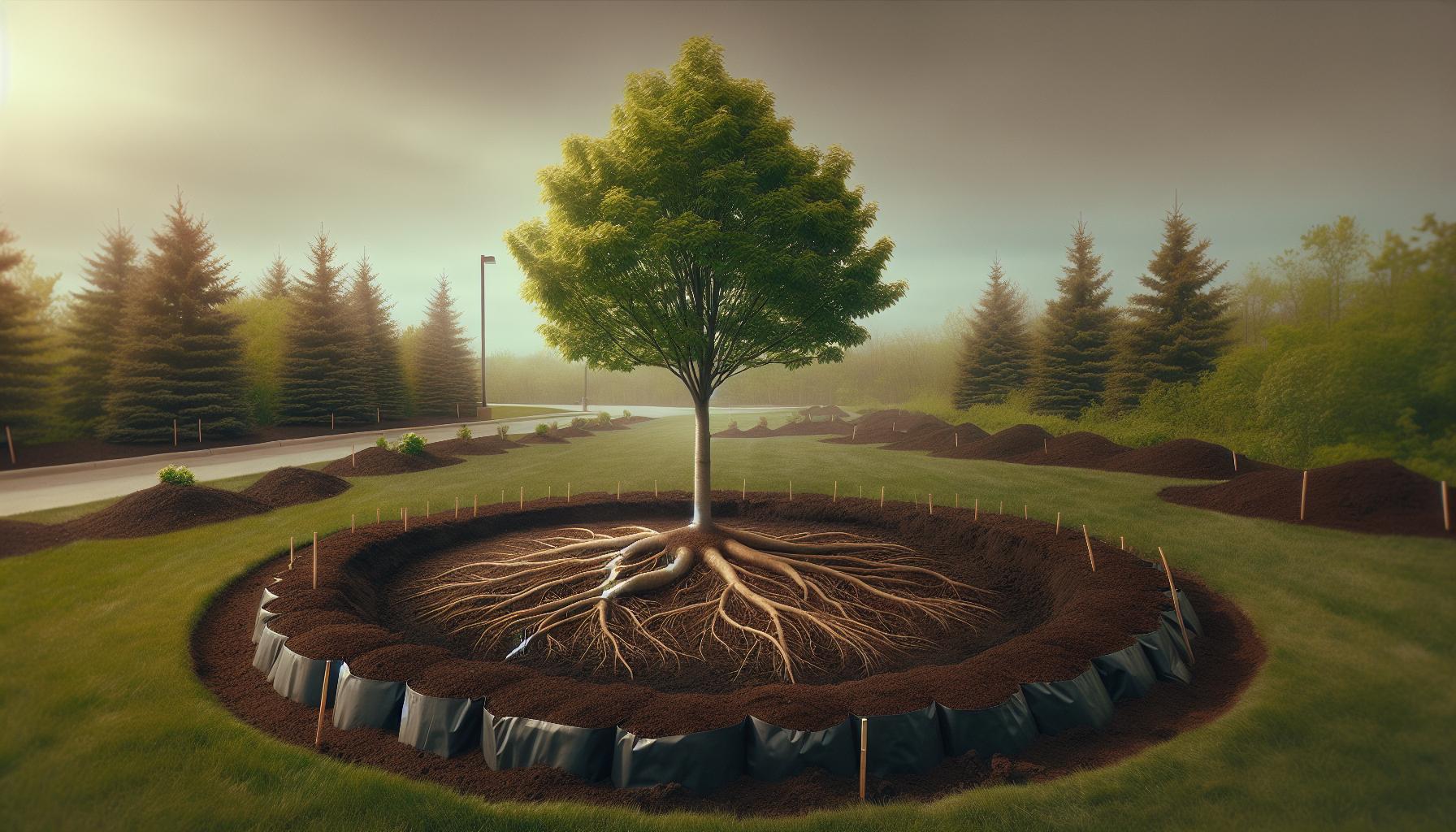Planting trees in Ontario isn’t just a matter of digging a hole and hoping for the best; timing is everything. Knowing when to plant trees in this diverse province is crucial for their survival and growth. With Ontario’s varying climate zones, getting your timing right is essential to ensure your trees thrive.
Spring and fall are often touted as the best times to plant trees in Ontario, but there’s more to it than just the seasons. You’ll want to consider the specific needs of the tree species you’re planting and the local weather conditions in your area. Let’s dive into the nuances of planting trees in Ontario, ensuring you give your green giants the best start possible.
Best Time to Plant Trees in Ontario
When planning to introduce new trees into your garden or landscape in Ontario, timing isn’t just a suggestion; it’s pivotal for their survival and flourishing. The diverse climate zones across Ontario mean what works in one area might not be ideal in another. However, there are general guidelines that can help you make informed decisions.
Spring and autumn emerge as the most favourable times to plant trees in this region. Let’s break down the reasons why.
During the spring, specifically from late April to June, the warming soil temperatures and increased rainfall provide a nurturing environment for young trees to establish roots. Importantly, planting early in this window allows trees to settle in before the heat of summer, which can stress young plants.
On the flip side, autumn, particularly from late September to November, offers its own set of advantages. The cooler temperatures and gentle rains of autumn help trees to establish without the immediate threat of drought or extreme heat. Moreover, the ground is still warm enough from the summer months to encourage root growth before the onset of winter.
Here’s a quick snapshot of the best planting times:
| Season | Timeframe |
|---|---|
| Spring | Late April-June |
| Autumn | Late Sep-Nov |
Remember, while these timeframes are ideal for most trees, you should always consider the specific needs of the tree species you are planting. Some might prefer the brisk touch of autumn, while others thrive with the onset of spring.
You’ll also need to keep an eye on the local weather forecasts. An unusually warm autumn or a frost-delayed spring can shift the optimal planting times. Being adaptable to these conditions will help ensure your new trees get the best start possible.
In essence, matching your tree planting to these suggested times can significantly increase your success rate. Yet, always blend this guidance with an understanding of the tree species and the current year’s weather patterns to truly optimize planting success in Ontario.
Importance of Timing for Tree Planting

When it comes to planting trees in Ontario, understanding the importance of timing cannot be overstated. The right time to plant can significantly impact the survival rate of your trees, influencing how well they thrive in their new environment.
In Ontario, the seasons greatly dictate the best planting times. Spring and autumn are ideal because they offer conditions that support the healthy growth of young trees. During these months, the soil temperature begins to warm up or cool down to a moderate level, respectively, which is conducive to root development. Furthermore, the typically gentle precipitation in spring and autumn helps the soil retain the right amount of moisture, aiding in the tree’s establishment without the threat of drought or excessive waterlogging.
- Root establishment: Trees planted at the correct time have a better chance at establishing a strong root system before either the summer heat or winter cold.
- Growth cycles: Aligning tree planting with the tree’s natural growth cycles boosts their growth and survival chances.
- Weather conditions: Planting in harsh conditions can stress the trees, making them more susceptible to disease and pests.
However, it’s not just about the seasons. Each tree species may have its preferences for planting times based on its unique growth cycle and environmental requirements. It’s crucial to research the specific needs of the tree type you’re planning to plant. For example, deciduous trees generally fare better when planted in autumn, while coniferous trees can be more flexible with spring or autumn planting.
Incorporating this knowledge into your gardening practices will help ensure that your trees get the best start possible. By paying close attention to the timing of tree planting in Ontario, you’re laying the groundwork for a lush, vibrant landscape. Remember, successful tree planting is as much about when you plant as it is about how you plant.
Factors to Consider Before Planting Trees

When embarking on your tree planting journey in Ontario, it’s pivotal to weigh several factors before digging into the soil. These considerations ensure you’re not just planting but nurturing a future forest or garden that thrives.
Tree Species Selection is at the forefront of these considerations. Different species have unique needs and adapt differently to Ontario’s climate zones. Researching and choosing trees native to Ontario or those well-adapted to your local climate zone can drastically increase your success rate. Native species like the Sugar Maple or White Pine are excellent choices, given their adaptability to local conditions.
Soil Condition plays a crucial role in the health and growth of your trees. Before planting, assess the soil’s drainage capability and pH level. Trees require well-draining soil to prevent root rot, and the pH level can affect nutrient availability. Amending your soil based on the specific needs of your chosen tree species could be necessary for optimal growth.
Sunlight and Space considerations are vital. Tree saplings need a considerable amount of sunlight and space to expand. It’s important to plant where the tree will receive adequate sunlight throughout the day and where it has room to grow both above and below ground. Future obstructions, such as buildings, other trees, or utility lines, should be taken into account to avoid future complications.
Lastly, consider Environmental Impact. Planting trees not only contributes positively to your immediate surroundings but also to the broader ecosystem. They provide habitat and food for wildlife, enrich soil health, and help combat climate change by absorbing carbon dioxide. Your contribution to creating a greener Ontario begins with a single tree but its impact resonates on a global scale.
Incorporating these factors into your planning process equips you with the knowledge to make informed decisions and set your tree planting project up for success.
Specific Needs of Tree Species in Ontario

Understanding the specific needs of tree species in Ontario is crucial for ensuring their health and longevity. Different species of trees have varied requirements for optimal growth, including sunlight exposure, water, soil type, and temperature tolerance. By familiarizing yourself with these needs, you can select the right tree for your location and help it thrive.
Sunlight is a primary factor in a tree’s health. Some trees, like the Silver Maple and the Eastern White Pine, can tolerate or even prefer partial shade. Others, such as the Red Oak and Sugar Maple, require full sunlight to flourish. Knowing the sunlight requirements of your chosen species ensures they’re planted in locations where they can receive adequate light.
Soil condition plays a significant role in a tree’s success. Most trees in Ontario thrive in well-drained, fertile soils. However, certain species, like the Tamarack, can tolerate wetter conditions, whereas species like the White Pine prefer sandy or well-drained soils. Before planting, test your soil’s pH and texture to match the tree’s requirements.
Watering needs vary among trees, especially between native and non-native species. Native trees tend to be more drought-resistant once established, requiring less irrigation. In contrast, non-native species may require consistent watering schedules to ensure their root systems develop correctly and they remain healthy.
Here’s a quick guide on the sunlight and soil preferences for some popular trees in Ontario:
| Tree Species | Sunlight Exposure | Soil Preference |
|---|---|---|
| Silver Maple | Partial Shade | Moist, Well-Drained |
| Eastern White Pine | Full Sun/Partial | Sandy, Well-Drained |
| Red Oak | Full Sun | Loamy, Well-Drained |
| Sugar Maple | Full Sun | Fertile, Well-Drained |
| Tamarack | Full Sun | Acidic, Wet |
| White Pine | Full Sun | Sandy, Well-Drained |
Considering these aspects when planning your tree planting project in Ontario will not only aid in the selection of the right tree but also promote a healthy, thriving tree that can withstand local climate challenges.
Local Weather Conditions and Tree Planting

In Ontario, understanding local weather conditions is critical to the successful planting and growth of your trees. The region’s diverse climate means that timing can significantly impact the health and survival of newly planted trees.
Ontario experiences a wide range of temperatures throughout the year, from hot summers to cold winters. This variance affects not only when you should plant but also what species are most likely to thrive in your local environment. Typically, the optimal planting times in Ontario are during the spring and fall. These seasons offer milder temperatures and more consistent moisture levels, crucial for helping young trees establish their root systems.
Spring Planting
Spring is often considered the best time to plant. After the last frost date, when the soil is workable and before the peak summer heat, offers young trees a good start. The moderate temperatures and increased rainfall support root growth, making it easier for trees to become established before summer stressors like heat and drought set in.
Fall Planting
Fall planting, ideally between late August and mid-October, allows trees to establish roots in cooler temperatures before the ground freezes. During this time, trees are typically entering a period of dormancy, focusing their energy on root development rather than foliage. Additionally, fall precipitation helps ensure the soil remains moist, providing a nurturing environment for new plantings.
Weather Considerations
When planning your tree planting, always monitor the local forecast. Sudden temperature swings or unexpected frost can harm young trees. It’s advisable to wait for a stable weather pattern to ensure the best start for your new trees. Moreover, selecting species that are well-adapted to Ontario’s climate will further enhance the success rate of your planting efforts.
By aligning your tree planting activities with the nuances of Ontario’s weather conditions, you’re not just planting trees; you’re nurturing future landscapes. It’s about making informed decisions that will benefit both the environment and your community for years to come.
Conclusion
Planting trees in Ontario requires a thoughtful approach, taking into account the local weather conditions to ensure your trees thrive. Whether you choose the rejuvenating atmosphere of spring or the calm coolness of fall for planting, your efforts can significantly impact the health and growth of your trees. By focusing on species that are well-suited to Ontario’s climate and timing your planting to coincide with the most favourable conditions, you’re setting the stage for a greener, more resilient landscape. Remember, the right time to plant is when conditions align with the needs of your chosen species, ensuring they have the best start possible. Your contribution to the environment and community is invaluable, fostering a legacy of sustainability and beauty for future generations.
Frequently Asked Questions (FAQ)
What is the best time to plant trees in Ontario?
The optimal times for planting trees in Ontario are during the spring and fall. Spring planting benefits from moderate temperatures and increased rainfall, facilitating root growth before the summer. Fall planting leverages cooler temperatures to focus on root development before the winter arrives.
Why is local weather important for planting trees?
Local weather conditions greatly influence tree health and survival. Understanding the region’s varying temperatures is crucial for choosing the right time to plant trees. This ensures they are established properly under suitable conditions, enhancing their growth and resilience.
Are certain tree species more suited to Ontario’s climate?
Yes, it’s recommended to select tree species that are adapted to Ontario’s climate. Considering the local weather conditions, such as varying temperatures throughout the year, ensures that the trees can thrive in their environment. This approach contributes to the success of growing healthy and robust future landscapes.
How does planting trees benefit the environment and community?
Planting trees nurtures future landscapes, which benefits both the environment and community in the long term. Trees help in purifying the air, providing habitats for wildlife, reducing urban heat, and enhancing the mental and physical well-being of the community members. They play a crucial role in creating sustainable and healthier environments.


